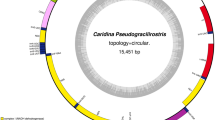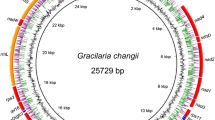Abstract
Macrocystis pyrifera (Linnaeus) C. Agardh 1820 is a type of algae widely located along the Chilean coastline with extensive biological value. Mitochondrial genome is 37 289 bp in length and consists of a circular DNA molecule. The circular genome is composed of 66 genes, including 38 protein coding genes, 25 tRNA genes, and 3 rRNA genes. The total content of G+C is 31.80%, lower than that of A+T. M. pyrifera formed a monophyletic clade together with Macrocystis integrifolia, which offer valuable insights into the phylogeny and gene functions within the family Laminariaceae andpromote novel references for the genetic and phylogenetic research of M. pyrifera through the provision of these data.
Similar content being viewed by others
Avoid common mistakes on your manuscript.
Macrocystis pyrifera (Linnaeus) C. Agardh 1820 belongs to the class Phaeophyceae, order Laminariales, and family Laminariaceae [1]. This species exhibits remarkable adaptability to intricate intertidal habitats and has the capability to sustain its basal metabolism even in exceedingly harsh environmental conditions (Fig. 1). The biological characteristics and distribution patterns of M. pyrifera are distinctly unique, rendering it an exemplary subject for phylogeographic investigations [2]. It is frequently utilized as a primary resource for microbial fermentation and the conversion of carbohydrates into environmentally sustainable bioactive compounds. This practice not only yields substantial economic benefits but also contributes positively to ecological preservation [3]. In recent years, M. pyrifera has garnered extensive attention from scientific researchers engaged in marine ecosystem development and the exploration of bioactive substances.
The fresh specimens were collected from the intertidal rocky shores of Playa Rosada, located along the coast of Valdivia in southern Chile (39°39′ S, 73°13′ W). These specimens have been meticulously preserved under voucher number FIO2023031201 at the First Institute of Oceanography, Ministry of Natural Resources (https://www.fio.org.cn/, Jinlai Miao, miaojinlai@fio.org.cn).
The construction of the whole genome library of the M. pyrifera mitochondrion was carried out by Shanghai Biozeron Biological Technology Co. Ltd. Genomic DNA extraction was performed using a modified cetyltrimethylammonium bromide (CTAB) method. Subsequently, the extracted DNA was utilized for the construction of a 500-bp paired-end library using the NEBNext Ultra DNA Library Prep Kit, designed for Illumina sequencing [4]. Then, we employed the Illumina NovaSeq 6000 platform for paired-end sequencing. The mitochondrial genes were meticulously annotated through the utilization of the GeSeq online tool, employing default parameters for the prediction of protein-coding genes, tRNA, and rRNA. The precise positioning of each coding gene was ascertained through thorough BLAST searches against reference mitochondrial genes. NOVOPlasty v4.2 software was utilized to assemble the mitochondrial genome of M. pyrifera. By enhancing the quality of the original data through quality filtering, we achieved a more accurate assembly, which enabled the prediction of functional genes [5, 6]. The depth of coverage was determined by aligning the reads to the mitochondrial genome sequence with bowtie2 v2.3.4.3, facilitating the evaluation of assembly accuracy [7]. The mitochondrial genome map of M. pyrifera was drawn using the OGDRAW tool [8]. Functional annotations were performed using sequence-similarity Blast searches with a typical cut-off E-value of 10–5 against several publicly available protein database of Kyoto Encyclopedi of Genes and Genomes (KEGG).
We employed MEGA 7.0 for the construction of multiple sequence alignments, aimed at elucidating the phylogenetic relationship of M. pyrifera. Subsequently, a maximum-likelihood (ML) phylogenetic tree was generated using the mitochondrial genomes of 26 species selected from the NCBI-GenBank database. In this analysis, the nucleotide substitution model utilized was the General Time Reversible (GTR, nst = 6) model [9].
The mitochondrial genome was 37 289 base pairs, with coding genes totaling 28 956 bp, constituting approximately 77.65% of the total length (Fig. 2). The mitochondrial genome sequence has 100% total coverage with an average of 181.42× base coverage, ranging from 3× to 353× (Fig. A1). The composition of the mitochondrial genome was as follows: 29.74% A, 38.47% T, 19.10% G, and 12.69% C, resulting in a G+C content of 31.80%. Within the coding genes, there were 25 tRNA genes, three rRNA genes and 38 protein-coding genes. Among the protein-coding genes, tatC and cob exhibit functions in environmental information processing, whereas atp9, nad1, nad5, nad7, cox1, cox3, and cob are associated with environmental adaptation (Table A1).
Schematic map of overall features of the M. pyrifera mitochondrial genome (The inner circle indicates the GC content, and the external circle indicates the genes having different colors based on their functions. The different colored legends in the bottom left corner represent genes with different functions).
The phylogenetic tree is divided into Laminariaceae, Alariaceae, Lessoniaceae, Acinetosporaceae, Chordariaceae, Scytosiphonaceae, Desmarestiaceae, Sargassaceae and Fucaceae at the family level (Fig. 3). Dictyota dichotoma was generatedas an outgroup. It is observed that M. pyrifera formed a monophyletic clade together with Macrocystis integrifolia. M. pyrifera and M. integrifoli have the closest genetic relationship and both of them belong to Laminariaceae.
In this study, we successfully assembled and analyzed the complete mitochondrial genome of M. pyrifera. The mitochondrial genome of M. pyrifera spans a length of 37 289 bp, with a notably high AT content. Additionally, phylogenetic analysis was conducted. The phylogenetic analysis confirmed that M. pyrifera exhibited the closest relationship with Macrocystis integrifolia. The complete mitochondrial genome of M. pyrifera contributed to an enhanced understanding of its phylogenetic position within phaeophyceae and the evolutionary dynamics of organellar genomes in brown algae, promotingnovel references for the genetic and phylogenetic research of M. pyrifera through the provision of these data. Genes with functions of environmental information processing and environmental adaptation play a pivotal role in M. pyrifera’s ability to adapt and response to external environmental changes. This contributes to our ongoing exploration of the intricacies of plant growth, development, and genes linked to environmental adaptation.
While the family Laminariaceae boasts a diverse array of species, the available plant sequences within the Laminariaceae remain relatively limited on NCBI. The revelation of the mitochondrial genome sequence of M. pyrifera will offer valuable insights into the phylogeny and gene functions within the family Laminariaceae. It is beneficial for enhancing the efficient utilization of natural resources and contributing to environmental conservation.
DATA AVAILABILITY
The genome sequence data that support the findings of this study are openly available in GenBank of NCBI (https://www.ncbi.nlm.nih.gov/) under the accession no. OR085995. All high-throughput sequencing data files are available fromthe GenBank Sequence ReadArchive (SRA) accession number: SRR24822458. The associated BioProject and Bio-Sample numbers are PRJNA984242 and SAMN35750362 respectively.
REFERENCES
Jackson, C., Salomaki, E.D., Lane, C.E., and Saunders, G.W., Kelp transcriptomes provide robust support for interfamilial relationships and revision of the little known Arthrothamnaceae (Laminariales), J. Phycol., 2016, vol. 53, no. 1, pp. 1—6. https://doi.org/10.1111/jpy.12465
Camus, C., Infante, J., and Buschmann, A.H., Revisiting the economic profitability of giant kelp Macrocystis pyrifera (Ochrophyta) cultivation in Chile, Aquaculture, 2019, vol. 502, pp. 80—86. https://doi.org/10.1016/j.aquaculture.2018.12.030
Leyton, A., Lienqueo, M.E., and Shene, C., Macrocystis pyrifera: substrate for the production of bioactive compounds, J. Appl. Phycol., 2019, vol. 32, no. 4, pp. 2335—2341. https://doi.org/10.1007/s10811-019-02018-x
Talbot, N.J., Salch, Y.P., Ma, M. and Hamer, J.E., Karyotypic variation within clonal lineages of the rice blast fungus, Magnaporthe grisea, Appl. Environ. Microbiol., 1993, vol. 59, no. pp. 585—593. https://doi.org/10.1128/aem.59.2.585-593.1993
Dierckxsens, N., Mardulyn, P., and Smits, G., NOVOPlasty: de novo assembly of organelle genomes from whole genome data, Nucleic Acids Res., 2016, vol. 45, no. 4, p. e18. https://doi.org/10.1093/nar/gkw955
Tillich, M., Lehwark, P., Pellizzer, T., et al., GeSeq—versatile and accurate annotation of organelle genomes, Nucleic Acids Res., 2017, vol. 45, no. W1, pp. W6—W11. https://doi.org/10.1093/nar/gkx391
Langmead, B. and Salzberg, S.L., Fast gapped-read alignment with Bowtie 2, Nat. Methods, 2012, vol. 9, no. 4, pp. 357—359. https://doi.org/10.1038/NMETH.1923
Lohse, M., Drechsel, O., and Bock, R., OrganellarGenomeDRAW (OGDRAW): a tool for the easy generation of high-quality custom graphical maps of plastid and mitochondrial genomes, Curr. Genet., 2007, vol. 52, nos. 5–6, pp. 267—274. https://doi.org/10.1007/s00294-007-0161-y
Rodriguez, F., Oliver, J.L., Marín, A., and Medina, J.R., The general stochastic model of nucleotide substitution, J. Theor. Biol., 1990, vol. 142, no. 4, pp. 485—501. https://doi.org/10.1016/S0022-5193(05)80104-33(05)8-0104-3
Funding
This study was sustained by the National Key Research and Development Program of China (2023YFD2100604), Basic Scientific Fund for National Public Research Institutes of China (2022Q10), Natural Science Foundation of China (32000074, 42176130), Natural Science Foundation of Shandong (ZR2021MD044), and Jinan “20 new colleges and universities” funding project (202228041).
Author information
Authors and Affiliations
Contributions
Jinlai Miao gave final check, revision and approval of the version to be published. Shaoxin Liang performed an experiment and wrote a manuscript. Changfeng Qu analyzed the data. Fanye Wang conducted the experiment. Yingying He determined the experiment and collected the related materials. All authors have reviewed the manuscript and agree to be responsible for all aspects of the work.
Corresponding authors
Ethics declarations
ETHICS APPROVAL AND CONSENT TO PARTICIPATE
This work does not contain any studies involving human and animal subjects. The research on plant mitochondrial genome sequencing does not require ethical approval. All collection and sequencing work are strictly carried out in accordance with local legislation and relevant laboratory regulations to protect wild resources.
CONFLICT OF INTEREST
The authors of this work declare that they have no conflicts of interest.
DISCLOSURE STATEMENT
No potential competing interest was reported by the author(s).
Additional information
Publisher’s Note.
Pleiades Publishing remains neutral with regard to jurisdictional claims in published maps and institutional affiliations.
Supplementary Information
Rights and permissions
About this article
Cite this article
Liang, S.X., He, Y.Y., Qu, C.F. et al. The Complete Mitochondrial Genome of Macrocystis pyrifera (Linnaeus) C. Agardh 1820 and Phylogenetic Analysis. Russ J Genet 60, 1139–1142 (2024). https://doi.org/10.1134/S1022795424700625
Received:
Revised:
Accepted:
Published:
Issue Date:
DOI: https://doi.org/10.1134/S1022795424700625







